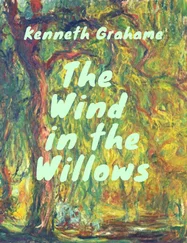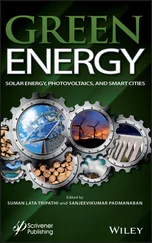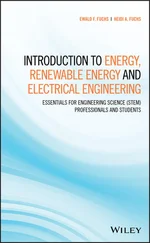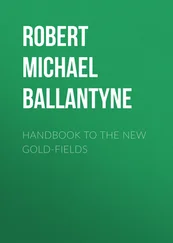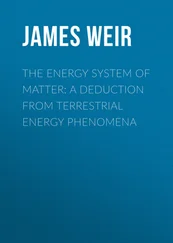8 Chapter 7Figure 7.1 Blade cross‐sectional outlines at stations along the length of a ...Figure 7.2 Wood‐epoxy blade construction utilising full blade shell. Source:...Figure 7.3 Wood‐epoxy blade construction utilising forward half of blade she...Figure 7.4 Glass fibre blade construction using blade skins in forward porti...Figure 7.5 Glass fibre blade construction with twin I‐beams, each formed of ...Figure 7.6 Glass fibre blade construction with box section spar consisting o...Figure 7.7 Failure strain distribution of individual fibres compared with pl...Figure 7.8 Two stress distributions on a + 45/−45° laminate, which, when com...Figure 7.9 Strain‐life regression lines fitted to results of constant amplit...Figure 7.10 CLD in terms of stress for DD16 MD laminate with 36% fibre volum...Figure 7.11 CLD in terms of strain for QQ1 triaxial laminate with 53% fibre ...Figure 7.12 CLD in terms of strain for Optimat MD2 triaxial laminate with 64...Figure 7.13 Linear CLD in terms of characteristic strainsFigure 7.14 Modified linear CLD in terms of characteristic strains, based on...Figure 7.15 Reduction of residual strength with number of constant amplitude...Figure 7.16 Two‐block high–low R = 0.1 fatigue loading, with half the predic...Figure 7.17 Two‐block low–high R = 0.1 fatigue loading, with half the predic...Figure 7.18 CLD for P2B hybrid laminate with 55% fibre volume fraction and [...Figure 7.19 Variation of blade root out‐of‐plane bending moment with wind sp...Figure 7.20 Variation of blade root flapwise bending moment with wind speed ...Figure 7.21 Effect of rapid wind speed fluctuations on 0 m radius flapwise b...Figure 7.22 Relative contribution to lifetime fatigue damage for different w...Figure 7.23 Time history of flapwise BM at 0 m radius, with breakdown betwee...Figure 7.24 FC40 blade plan‐formFigure 7.25 FC40 blade twist and thickness/chord ratio distributionsFigure 7.26 Cross‐section of blade at 32.5% radiusFigure 7.27 Spar cap thickness profile and combined thickness of inner and o...Figure 7.28 Variation of fatigue stresses at 17 m radius with wind speed for...Figure 7.29 Variation of fatigue damage with wind speed at 17 m radiusFigure 7.30 (a) Velocity diagram for vibrating blade (looking towards hub). ...Figure 7.31 Variation in damping coefficient at 14 m radius with vibration d...Figure 7.32 Typical buckling mode shape of DTU 10 MW reference turbine sucti...Figure 7.33 Typical buckling mode shape of DTU 10 MW reference turbine sucti...Figure 7.34 Curved panel spanning between shear websFigure 7.35 Variation of axial critical buckling stress with panel width for...Figure 7.36 Variation of axial critical buckling stress with curvature for 5...Figure 7.37 (a) Carrot connector, (b) T‐bolt connector, (c) pin‐hole flange,...Figure 7.38 Blade cross‐section (looking towards hub) and plan view on blade...Figure 7.39 In‐plane contraction and shear distortion of section of suction ...Figure 7.40 Variation with fibre inclination of ϒ xy/ σ x=  , spar cap lo...Figure 7.41 Variation of coupling coefficients at 62.5% and 32.5% radius for...Figure 7.42 Variation of bending moment fluctuations at blade passing freque...Figure 7.43 Proposed use of fore and aft blade sweep in combination with off...Figure 7.44 Typical pitch bearing arrangmentFigure 7.45 (a) Single‐row crossed roller bearings, (b) single‐row ball bear...Figure 7.46 (a) Tri‐cylindrical hub, and (b) spherical hubFigure 7.47 Rotor hub. View of spherical‐shaped rotor hub for the 1.5 MW NEG...Figure 7.48 Load duration curves for 500 kW, two bladed pitch‐regulated and ...Figure 7.49 Simulated power output for two bladed, 40 m dia pitch‐regulated ...Figure 7.50 Low‐speed shaft torque during braking at normal shut‐down. Extra...Figure 7.51 Specimen torque–endurance curves for gear tooth designFigure 7.52 Steady state equivalent circuit of an induction machine with pow...Figure 7.53 Variation of active power with slip for an induction machine sho...Figure 7.54 Circle diagram of 1 MW induction machineFigure 7.55 Soft‐start unit for an induction generator (one phase only shown...Figure 7.56 Steady state equivalent circuit of variable‐slip induction gener...Figure 7.57 Effect of external resistance on the torque slip curve of an ind...Figure 7.58 Voltage source converterFigure 7.59 (a) Sine‐triangular modulation circuit, and (b) PWM output of si...Figure 7.60 Ideal voltage sources representation of a voltage source convert...Figure 7.61 Typical harmonic spectrum of three phase voltage of a PWM invert...Figure 7.62 Steady state equivalent circuit of the DFIG. V ris the injected ...Figure 7.63 Steady state torque slip curves of a DFIGFigure 7.64 Torque speed curve of a DFIGFigure 7.65 Power flows in a DFIG. (a) Sub‐synchronous operation. (b) Super‐...Figure 7.66 Schematic of a DFIG wind turbine typical control systemFigure 7.67 Power flows in a full power converterFigure 7.68 High‐speed shaft brake disc and calliper (reproduced by permissi...Figure 7.69 Brake disc surface maximum temperature rise for emergency brakin...Figure 7.70 Emergency braking of stall‐regulated 60 m dia turbine from 10% o...Figure 7.71 Typical arrangement of yaw bearing, yaw drive, and yaw brakeFigure 7.72 Variation of dynamic magnification factors with tower natural fr...Figure 7.73 Variation of buckling strength reduction factor, divided by part...Figure 7.74 Variation in tower base wall thickness with diameter required fo...Figure 7.75 EN 1993‐1‐9:2005 fatigue strength curve for detail category 71 (...Figure 7.76 Bolted flange jointFigure 7.77 Flange joint bolt load variation with externally applied load, Z Figure 7.78 (a) Plain slab, (b) slab and pedestal, (c) stub tower embedded i...Figure 7.79 (a) Pile group and cap, (b) solid monopile, and (c) hollow monop...Figure 7.80 Piled foundation for steel lattice towerFigure 7.81 Example of variation of tower natural frequency with foundation ...
, spar cap lo...Figure 7.41 Variation of coupling coefficients at 62.5% and 32.5% radius for...Figure 7.42 Variation of bending moment fluctuations at blade passing freque...Figure 7.43 Proposed use of fore and aft blade sweep in combination with off...Figure 7.44 Typical pitch bearing arrangmentFigure 7.45 (a) Single‐row crossed roller bearings, (b) single‐row ball bear...Figure 7.46 (a) Tri‐cylindrical hub, and (b) spherical hubFigure 7.47 Rotor hub. View of spherical‐shaped rotor hub for the 1.5 MW NEG...Figure 7.48 Load duration curves for 500 kW, two bladed pitch‐regulated and ...Figure 7.49 Simulated power output for two bladed, 40 m dia pitch‐regulated ...Figure 7.50 Low‐speed shaft torque during braking at normal shut‐down. Extra...Figure 7.51 Specimen torque–endurance curves for gear tooth designFigure 7.52 Steady state equivalent circuit of an induction machine with pow...Figure 7.53 Variation of active power with slip for an induction machine sho...Figure 7.54 Circle diagram of 1 MW induction machineFigure 7.55 Soft‐start unit for an induction generator (one phase only shown...Figure 7.56 Steady state equivalent circuit of variable‐slip induction gener...Figure 7.57 Effect of external resistance on the torque slip curve of an ind...Figure 7.58 Voltage source converterFigure 7.59 (a) Sine‐triangular modulation circuit, and (b) PWM output of si...Figure 7.60 Ideal voltage sources representation of a voltage source convert...Figure 7.61 Typical harmonic spectrum of three phase voltage of a PWM invert...Figure 7.62 Steady state equivalent circuit of the DFIG. V ris the injected ...Figure 7.63 Steady state torque slip curves of a DFIGFigure 7.64 Torque speed curve of a DFIGFigure 7.65 Power flows in a DFIG. (a) Sub‐synchronous operation. (b) Super‐...Figure 7.66 Schematic of a DFIG wind turbine typical control systemFigure 7.67 Power flows in a full power converterFigure 7.68 High‐speed shaft brake disc and calliper (reproduced by permissi...Figure 7.69 Brake disc surface maximum temperature rise for emergency brakin...Figure 7.70 Emergency braking of stall‐regulated 60 m dia turbine from 10% o...Figure 7.71 Typical arrangement of yaw bearing, yaw drive, and yaw brakeFigure 7.72 Variation of dynamic magnification factors with tower natural fr...Figure 7.73 Variation of buckling strength reduction factor, divided by part...Figure 7.74 Variation in tower base wall thickness with diameter required fo...Figure 7.75 EN 1993‐1‐9:2005 fatigue strength curve for detail category 71 (...Figure 7.76 Bolted flange jointFigure 7.77 Flange joint bolt load variation with externally applied load, Z Figure 7.78 (a) Plain slab, (b) slab and pedestal, (c) stub tower embedded i...Figure 7.79 (a) Pile group and cap, (b) solid monopile, and (c) hollow monop...Figure 7.80 Piled foundation for steel lattice towerFigure 7.81 Example of variation of tower natural frequency with foundation ...
9 Chapter 8Figure 8.1 Low‐speed shaft sensing system. Three proximity sensors mounted o...Figure 8.2 Main control loop for a fixed‐speed pitch‐regulated turbineFigure 8.3 Schematic torque‐speed curve for a variable‐speed pitch‐regulated...Figure 8.4 Use of a tower accelerometer to help control tower vibrationFigure 8.5 Effect of a drive train damping filterFigure 8.6 Comparison of pitch and stall controlFigure 8.7 A simple control algorithm for variable‐speed stall regulationFigure 8.8 Operating envelope for a variable‐slip generatorFigure 8.9 Effect of individual pitch control on rotating out‐of‐plane loads...Figure 8.10 Effect of individual pitch control on yaw moment. Top: without i...Figure 8.11 Effect of 1P and 2P individual pitch control on non‐rotating loa...Figure 8.12 Adding higher harmonic individual pitch control loopsFigure 8.13 Possible LiDAR scanning pattern: a five‐lobed cycloidal scan is ...Figure 8.14 Typical linearised turbine modelFigure 8.15 Simplified general model of plant and controllerFigure 8.16 Damping ratio for a complex pole pairFigure 8.17 Example root locus plot for a variable‐speed pitch controllerFigure 8.18 Pitch rate limit modification for a variable‐slip wind turbineFigure 8.19 Structure of the LQG controllerFigure 8.20 Limits applied to a PI controller
10 Chapter 9Figure 9.1 Diagram of the Jensen velocity deficit model.Figure 9.2 Typical Gaussian wake velocity profile from the Ainslie model.Figure 9.3 Wake steering control by yawing (schematic).
11 Chapter 10Figure 10.1 (a) Binned PDF of wind speed. (b) Power curve at each wind speed...Figure 10.2 Scatter plot for MCP.Figure 10.3 Example of an energy map (GWh/year) of a prospective wind farm s...Figure 10.4 Wind farm of six 660 kW turbines in flat terrain.Figure 10.5 Wind farm of 600 kW turbines at Tarifa, Spain.Figure 10.6 Wind farm of 700 kW turbines along a coast.Figure 10.7 Large wind farm on flat upland terrain.Figure 10.8 Example of ZTV (visual impact) of a wind farm. See Plate 4 for c...Figure 10.9 Example of wireframe showing visibility of three wind farms.Figure 10.10 Example of photomontage.Figure 10.11 (a) 3‐D view of a wind farm. (b) 3‐D view within a wind farm. (...Figure 10.12 Example of shadow flicker prediction. The continuous line shows...Figure 10.13 Noise contours around a small wind farm.Figure 10.14 Example of noise criterion proposed by the UKWorking Group on N...Figure 10.15 Example of noise criterion proposed by the UKWorking Group on N...Figure 10.16 Interference mechanisms of wind turbines with radio systems.Figure 10.17 Interference regions of a wind turbine.Figure 10.18 Illustration of first Fresnel zone (Fresnel ellipsoid).Figure 10.19 Example of areas where a wind turbine would mask radar.Figure 10.20 Evaluation of the impact of wind turbines on radar.
Читать дальше
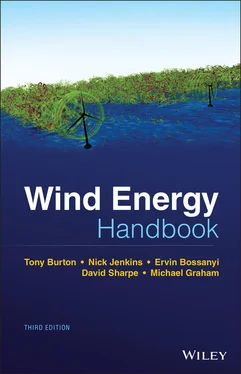
 , spar cap lo...Figure 7.41 Variation of coupling coefficients at 62.5% and 32.5% radius for...Figure 7.42 Variation of bending moment fluctuations at blade passing freque...Figure 7.43 Proposed use of fore and aft blade sweep in combination with off...Figure 7.44 Typical pitch bearing arrangmentFigure 7.45 (a) Single‐row crossed roller bearings, (b) single‐row ball bear...Figure 7.46 (a) Tri‐cylindrical hub, and (b) spherical hubFigure 7.47 Rotor hub. View of spherical‐shaped rotor hub for the 1.5 MW NEG...Figure 7.48 Load duration curves for 500 kW, two bladed pitch‐regulated and ...Figure 7.49 Simulated power output for two bladed, 40 m dia pitch‐regulated ...Figure 7.50 Low‐speed shaft torque during braking at normal shut‐down. Extra...Figure 7.51 Specimen torque–endurance curves for gear tooth designFigure 7.52 Steady state equivalent circuit of an induction machine with pow...Figure 7.53 Variation of active power with slip for an induction machine sho...Figure 7.54 Circle diagram of 1 MW induction machineFigure 7.55 Soft‐start unit for an induction generator (one phase only shown...Figure 7.56 Steady state equivalent circuit of variable‐slip induction gener...Figure 7.57 Effect of external resistance on the torque slip curve of an ind...Figure 7.58 Voltage source converterFigure 7.59 (a) Sine‐triangular modulation circuit, and (b) PWM output of si...Figure 7.60 Ideal voltage sources representation of a voltage source convert...Figure 7.61 Typical harmonic spectrum of three phase voltage of a PWM invert...Figure 7.62 Steady state equivalent circuit of the DFIG. V ris the injected ...Figure 7.63 Steady state torque slip curves of a DFIGFigure 7.64 Torque speed curve of a DFIGFigure 7.65 Power flows in a DFIG. (a) Sub‐synchronous operation. (b) Super‐...Figure 7.66 Schematic of a DFIG wind turbine typical control systemFigure 7.67 Power flows in a full power converterFigure 7.68 High‐speed shaft brake disc and calliper (reproduced by permissi...Figure 7.69 Brake disc surface maximum temperature rise for emergency brakin...Figure 7.70 Emergency braking of stall‐regulated 60 m dia turbine from 10% o...Figure 7.71 Typical arrangement of yaw bearing, yaw drive, and yaw brakeFigure 7.72 Variation of dynamic magnification factors with tower natural fr...Figure 7.73 Variation of buckling strength reduction factor, divided by part...Figure 7.74 Variation in tower base wall thickness with diameter required fo...Figure 7.75 EN 1993‐1‐9:2005 fatigue strength curve for detail category 71 (...Figure 7.76 Bolted flange jointFigure 7.77 Flange joint bolt load variation with externally applied load, Z Figure 7.78 (a) Plain slab, (b) slab and pedestal, (c) stub tower embedded i...Figure 7.79 (a) Pile group and cap, (b) solid monopile, and (c) hollow monop...Figure 7.80 Piled foundation for steel lattice towerFigure 7.81 Example of variation of tower natural frequency with foundation ...
, spar cap lo...Figure 7.41 Variation of coupling coefficients at 62.5% and 32.5% radius for...Figure 7.42 Variation of bending moment fluctuations at blade passing freque...Figure 7.43 Proposed use of fore and aft blade sweep in combination with off...Figure 7.44 Typical pitch bearing arrangmentFigure 7.45 (a) Single‐row crossed roller bearings, (b) single‐row ball bear...Figure 7.46 (a) Tri‐cylindrical hub, and (b) spherical hubFigure 7.47 Rotor hub. View of spherical‐shaped rotor hub for the 1.5 MW NEG...Figure 7.48 Load duration curves for 500 kW, two bladed pitch‐regulated and ...Figure 7.49 Simulated power output for two bladed, 40 m dia pitch‐regulated ...Figure 7.50 Low‐speed shaft torque during braking at normal shut‐down. Extra...Figure 7.51 Specimen torque–endurance curves for gear tooth designFigure 7.52 Steady state equivalent circuit of an induction machine with pow...Figure 7.53 Variation of active power with slip for an induction machine sho...Figure 7.54 Circle diagram of 1 MW induction machineFigure 7.55 Soft‐start unit for an induction generator (one phase only shown...Figure 7.56 Steady state equivalent circuit of variable‐slip induction gener...Figure 7.57 Effect of external resistance on the torque slip curve of an ind...Figure 7.58 Voltage source converterFigure 7.59 (a) Sine‐triangular modulation circuit, and (b) PWM output of si...Figure 7.60 Ideal voltage sources representation of a voltage source convert...Figure 7.61 Typical harmonic spectrum of three phase voltage of a PWM invert...Figure 7.62 Steady state equivalent circuit of the DFIG. V ris the injected ...Figure 7.63 Steady state torque slip curves of a DFIGFigure 7.64 Torque speed curve of a DFIGFigure 7.65 Power flows in a DFIG. (a) Sub‐synchronous operation. (b) Super‐...Figure 7.66 Schematic of a DFIG wind turbine typical control systemFigure 7.67 Power flows in a full power converterFigure 7.68 High‐speed shaft brake disc and calliper (reproduced by permissi...Figure 7.69 Brake disc surface maximum temperature rise for emergency brakin...Figure 7.70 Emergency braking of stall‐regulated 60 m dia turbine from 10% o...Figure 7.71 Typical arrangement of yaw bearing, yaw drive, and yaw brakeFigure 7.72 Variation of dynamic magnification factors with tower natural fr...Figure 7.73 Variation of buckling strength reduction factor, divided by part...Figure 7.74 Variation in tower base wall thickness with diameter required fo...Figure 7.75 EN 1993‐1‐9:2005 fatigue strength curve for detail category 71 (...Figure 7.76 Bolted flange jointFigure 7.77 Flange joint bolt load variation with externally applied load, Z Figure 7.78 (a) Plain slab, (b) slab and pedestal, (c) stub tower embedded i...Figure 7.79 (a) Pile group and cap, (b) solid monopile, and (c) hollow monop...Figure 7.80 Piled foundation for steel lattice towerFigure 7.81 Example of variation of tower natural frequency with foundation ...

